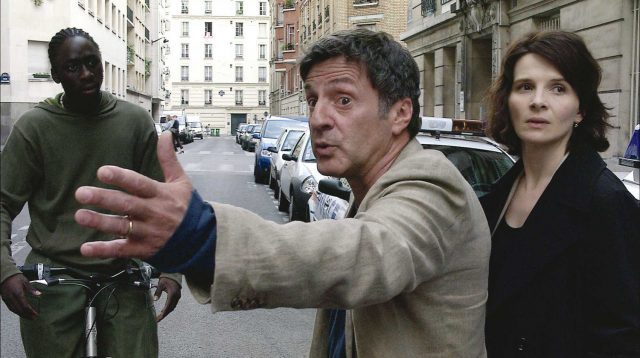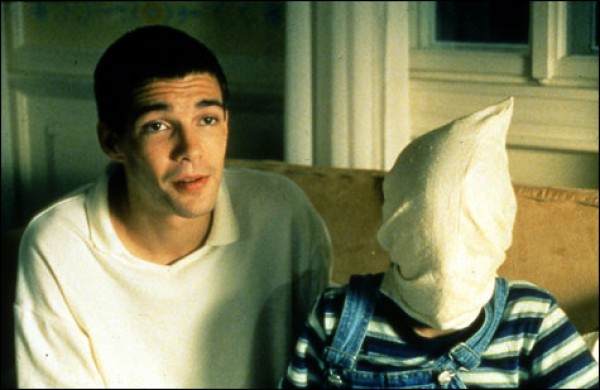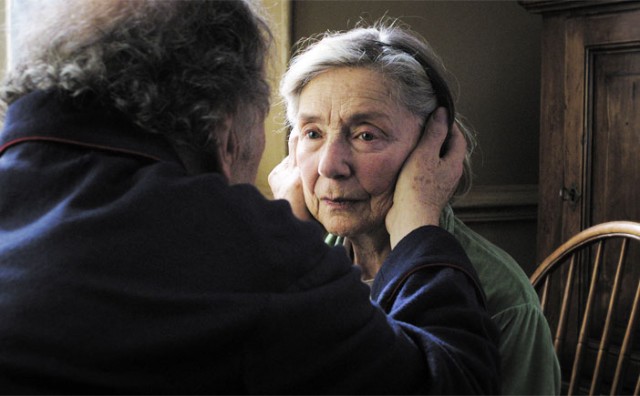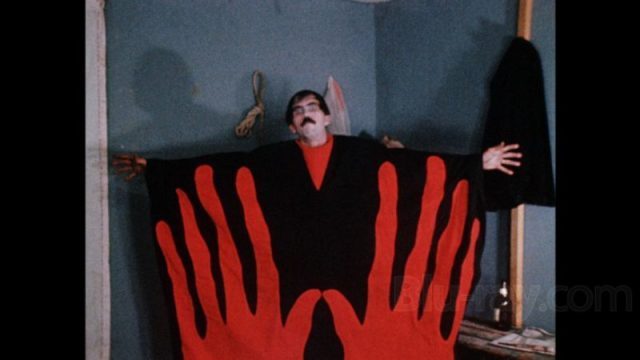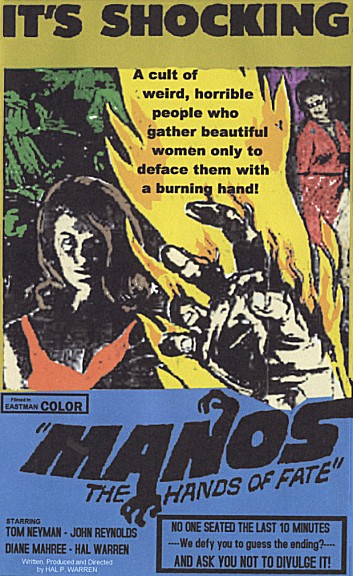ACCATTONE (THE SCROUNGER) (Pier Paolo Pasolini, 1961)
Quad Cinema
34 West 13th St. between Fifth & Sixth Aves.
Sunday, November 26, 5:50
Series runs November 22-30
212-255-2243
quadcinema.com
 After collaborating on a number of works by such auteurs as Mauro Bolognini and Federico Fellini, poet and novelist Pier Paolo Pasolini made his directorial debut in 1961 with the gritty, not-quite-neo-realist Accattone (“scrounger” or “beggar”). Somewhat related to his books Ragazzi di vita and Una vita violenta, the film is set in the Roman borgate, where brash young Vittorio “Accattone” Cataldi (Franco Citti) survives by taking crazy bets — like swimming across a river known for swallowing up people’s lives — and working as a pimp. After a group of local men beat up his main money maker (Silvana Corsini), he meets the more naive Stella (Franca Pasut), whom he starts dating with an eye toward perhaps converting into a prostitute as well. Meanwhile, he tries to establish a relationship with his son, but his estranged wife and her family want nothing to do with him. Filmed in black-and-white by master cinematographer Tonino Delli Colli, Accattone is highlighted by a series of memorable shots, from Accattone’s gorgeous dive from a bridge to a close-up of his face covered in sand, many of which were inspired by Baroque art and set to music by Bach. Written with Sergio Citti and featuring an assistant director named Bernardo Bertolucci — whose father was a friend of Pasolini’s — the story delves into the dire poverty in the slums of Rome, made all the more real by Pasolini’s use of both professional and nonprofessional actors. “Because he did not have much knowledge of film-making, he invented cinema. It was as though I had the privilege of assisting, of witnessing the invention of cinema by Pasolini,” Bertolucci later said of his experience. Accattone is screening November 26 as part of the Quad series “Pictures from the Revolution: Bertolucci’s Italian Period,” which runs November 24-30 and includes such other films that Bertolucci worked on, either as writer or director or in another capacity, as The Grim Reaper, Luna, Partner, 1900, the omnibus Love and Anger, and Sergio Leone’s Once Upon a Time in the West.
After collaborating on a number of works by such auteurs as Mauro Bolognini and Federico Fellini, poet and novelist Pier Paolo Pasolini made his directorial debut in 1961 with the gritty, not-quite-neo-realist Accattone (“scrounger” or “beggar”). Somewhat related to his books Ragazzi di vita and Una vita violenta, the film is set in the Roman borgate, where brash young Vittorio “Accattone” Cataldi (Franco Citti) survives by taking crazy bets — like swimming across a river known for swallowing up people’s lives — and working as a pimp. After a group of local men beat up his main money maker (Silvana Corsini), he meets the more naive Stella (Franca Pasut), whom he starts dating with an eye toward perhaps converting into a prostitute as well. Meanwhile, he tries to establish a relationship with his son, but his estranged wife and her family want nothing to do with him. Filmed in black-and-white by master cinematographer Tonino Delli Colli, Accattone is highlighted by a series of memorable shots, from Accattone’s gorgeous dive from a bridge to a close-up of his face covered in sand, many of which were inspired by Baroque art and set to music by Bach. Written with Sergio Citti and featuring an assistant director named Bernardo Bertolucci — whose father was a friend of Pasolini’s — the story delves into the dire poverty in the slums of Rome, made all the more real by Pasolini’s use of both professional and nonprofessional actors. “Because he did not have much knowledge of film-making, he invented cinema. It was as though I had the privilege of assisting, of witnessing the invention of cinema by Pasolini,” Bertolucci later said of his experience. Accattone is screening November 26 as part of the Quad series “Pictures from the Revolution: Bertolucci’s Italian Period,” which runs November 24-30 and includes such other films that Bertolucci worked on, either as writer or director or in another capacity, as The Grim Reaper, Luna, Partner, 1900, the omnibus Love and Anger, and Sergio Leone’s Once Upon a Time in the West.
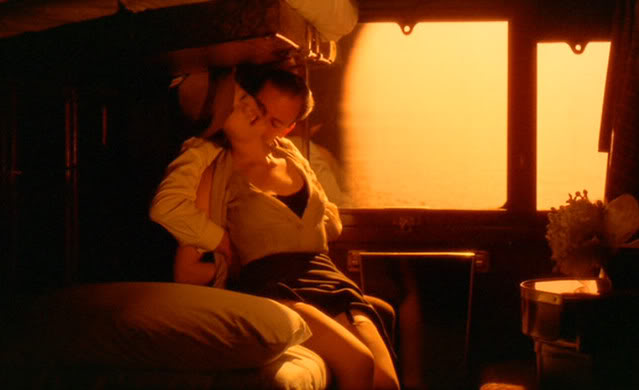
Jean-Paul Trintignant tries to find his place in the world in Bernardo Bertolucci’s lush masterpiece, The Conformist
THE CONFORMIST (Bernardo Bertolucci, 1970)
Thursday, November 23, 1:00, 5:45
Saturday, November 25, 7:30
Wednesday, November 29, 9:20
quadcinema.com
 Based on the novel by Alberto Moravia, Bernardo Bertolucci’s gorgeous masterpiece, The Conformist, is a political thriller about paranoia, pedophilia, and trying to find one’s place in a changing world. Jean-Louis Trintignant (And God Created Woman, Z, My Night at Maud’s) stars as Marcello Clerici, a troubled man who suffered childhood traumas and is now attempting to join the fascist secret police. To prove his dedication to the movement, he is ordered to assassinate one of his former professors, the radical Luca Quadri (Enzo Tarascio), who is living in France. He falls for Quadri’s much younger wife, Anna (Dominique Sanda), who takes an intriguing liking to Clerici’s wife, Giulia (Stefania Sandrelli), while Manganiello (Gastone Moschin) keeps a close watch on him, making sure he will carry out his assignment. The Conformist, made just after The Spider’s Stragagem and followed by Last Tango in Paris, captures one man’s desperate need to belong, to become a part of Mussolini’s fascist society and feel normal at the expense of his real inner feelings and beliefs. An atheist, he goes to church to confess because Giulia demands it. A bureaucrat, he is not a cold-blooded killer, but he will murder a part of his past in order to be accepted by the fascists (as well as Bertolucci’s own past, as he makes a sly reference to his former mentor, Jean-Luc Godard, by using the French auteur’s phone number and address for Quadri’s). Production designer Ferdinando Scarfiotti and cinematographer Vittorio Storaro bathe the film in lush Art Deco colors as Bertolucci moves the story, told in flashbacks, through a series of set pieces that include an erotic dance by Anna and Giulia, a Kafkaesque visit to a government ministry, and a stunning use of black and white and light and shadow as Marcello and Giulia discuss their impending marriage. A multilayered psychological examination of a complex figure living in complex times, as much about the 1930s as the 1970s, as the youth of the Western world sought personal, political, and sexual freedom, The Conformist is screening at the Quad on November 23, 25, and 29.
Based on the novel by Alberto Moravia, Bernardo Bertolucci’s gorgeous masterpiece, The Conformist, is a political thriller about paranoia, pedophilia, and trying to find one’s place in a changing world. Jean-Louis Trintignant (And God Created Woman, Z, My Night at Maud’s) stars as Marcello Clerici, a troubled man who suffered childhood traumas and is now attempting to join the fascist secret police. To prove his dedication to the movement, he is ordered to assassinate one of his former professors, the radical Luca Quadri (Enzo Tarascio), who is living in France. He falls for Quadri’s much younger wife, Anna (Dominique Sanda), who takes an intriguing liking to Clerici’s wife, Giulia (Stefania Sandrelli), while Manganiello (Gastone Moschin) keeps a close watch on him, making sure he will carry out his assignment. The Conformist, made just after The Spider’s Stragagem and followed by Last Tango in Paris, captures one man’s desperate need to belong, to become a part of Mussolini’s fascist society and feel normal at the expense of his real inner feelings and beliefs. An atheist, he goes to church to confess because Giulia demands it. A bureaucrat, he is not a cold-blooded killer, but he will murder a part of his past in order to be accepted by the fascists (as well as Bertolucci’s own past, as he makes a sly reference to his former mentor, Jean-Luc Godard, by using the French auteur’s phone number and address for Quadri’s). Production designer Ferdinando Scarfiotti and cinematographer Vittorio Storaro bathe the film in lush Art Deco colors as Bertolucci moves the story, told in flashbacks, through a series of set pieces that include an erotic dance by Anna and Giulia, a Kafkaesque visit to a government ministry, and a stunning use of black and white and light and shadow as Marcello and Giulia discuss their impending marriage. A multilayered psychological examination of a complex figure living in complex times, as much about the 1930s as the 1970s, as the youth of the Western world sought personal, political, and sexual freedom, The Conformist is screening at the Quad on November 23, 25, and 29.
LAST TANGO IN PARIS (ULTIMO TANGO A PARIGI) (Bernardo Bertolucci, 1972)
Thursday, November 23, 3:15, 8:00
Tuesday, November 28, 9:10
quadcinema.com
One of the most artistic films ever made about seduction, Bernardo Bertolucci’s X-rated Last Tango in Paris is also one of the most controversial. Written by Bertolucci with regular collaborator and editor Franco Arcalli and with French dialogue by Agnès Varda (Le Bonheur, Vagabond), the film opens with credits featuring jazzy romantic music by Argentine saxophonist Gato Barbieri and two colorful and dramatic paintings by Francis Bacon, “Double Portrait of Lucian Freud and Frank Auerbach” and “Study for a Portrait,” that set the stage for what is to follow. (Bacon was a major influence on the look and feel of the film, photographed by Vittorio Storaro.) Bertolucci then cuts to a haggard man (Marlon Brando) standing under the Pont de Bir-Hakeim in Paris, screaming out, “Fucking God!” His hair disheveled, he is wearing a long brown jacket and seems to be holding back tears. An adorable young woman (Maria Schneider) in a fashionable fluffy white coat and black hat with flowers passes by, stops and looks at him, then moves on. They meet again inside a large, sparsely furnished apartment at the end of Rue Jules Verne that they are each interested in renting. Both looking for something else in life, they quickly have sex and roll over on the floor, exhausted. For the next three days, they meet in the apartment for heated passion that the man, Paul, insists include nothing of the outside world — no references to names or places, no past, no present, no future; the young woman, Jeanne, agrees. Their sex goes from gentle and touching to brutal and animalistic; in fact, after one session, Bertolucci cuts to actual animals. The film is nothing if not subtle.
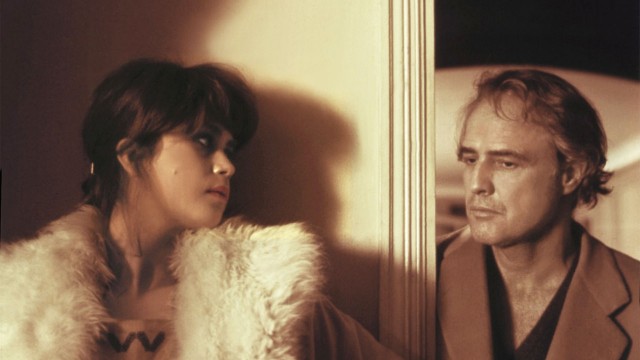
Jeanne (Maria Schneider) and Paul (Marlon Brando) share a private, sexual relationship in Last Tango in Paris
The lovers’ real lives are revealed in bits and pieces, as Paul tries to recover from his wife’s suicide and Jeanne deals with a fiancée, Thomas (Jean-Pierre Léaud), who has suddenly decided to make a film about them, without her permission, asking precisely the kind of questions that Paul never wants to talk about. When away from the apartment, Jeanne is shown primarily in the bright outdoors, flitting about fancifully and giving Thomas a hard time; in one of the only scenes in which she’s inside, Thomas makes a point of opening up several doors, preventing her from ever feeling trapped. Meanwhile, Paul is seen mostly in tight, dark spaces, especially right after having a fight with his dead wife’s mother. He walks into his hotel’s dark hallway, the only light coming from two of his neighbors as they open their doors just a bit to spy on him. Not saying anything, he pulls their doors shut as the screen goes from light to dark to light to dark again, and then Bertolucci cuts to Paul and Jeanne’s apartment door as she opens it, ushering in the brightness that always surrounds her. It’s a powerful moment that heightens the difference between the older, less hopeful man and the younger, eager woman. Inevitably, however, the safety of their private, primal relationship is threatened, and tragedy awaits.
“I’ve tried to describe the impact of a film that has made the strongest impression on me in almost twenty years of reviewing. This is a movie people will be arguing about, I think, for as long as there are movies,” Pauline Kael wrote in the New Yorker on October 28, 1972, shortly before Last Tango closed the tenth New York Film Festival. “It is a movie you can’t get out of your system, and I think it will make some people very angry and disgust others. I don’t believe that there’s anyone whose feelings can be totally resolved about the sex scenes and the social attitudes in this film.” More than forty years later, the fetishistic Last Tango in Paris still has the ability to evoke those strong emotions. The sex scenes range from tender, as when Jeanne tells Paul they should try to climax without touching, to when Paul uses butter in an attack that was not scripted and about which Schneider told the Daily Mail in 2007, “I felt humiliated and to be honest, I felt a little raped, both by Marlon and by Bertolucci. After the scene, Marlon didn’t console me or apologise. Thankfully, there was just one take.” At the time of the shooting, Brando was forty-eight and Schneider nineteen; Last Tango was released between The Godfather and Missouri Breaks, in which Brando starred with Jack Nicholson, while Schneider would go on to make Michelangelo Antonioni’s The Passenger with Nicholson in 1975. Brando died in 2004 at the age of eighty, leaving behind a legacy of more than forty films. Schneider died in 2011 at the age of fifty-eight; she also appeared in more than forty films, but she was never able to escape the associations that followed her after her breakthrough performance in Last Tango, which featured extensive nudity, something she refused to do ever again. Even in 2014, Last Tango in Paris is both sexy and shocking, passionate and provocative, alluring and disturbing, all at the same time, a movie that, as Kael said, viewers won’t easily be able to get out of their system. Last Tango in Paris is screening at the Quad November 23 and 28.

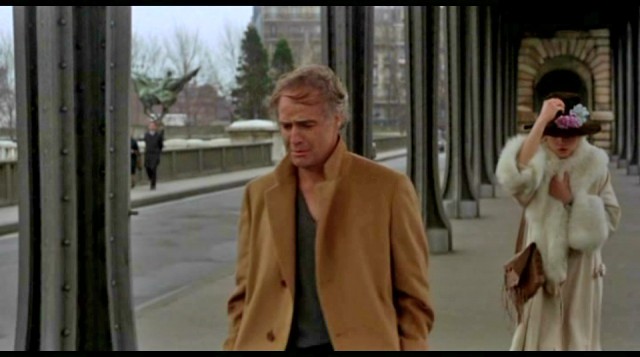
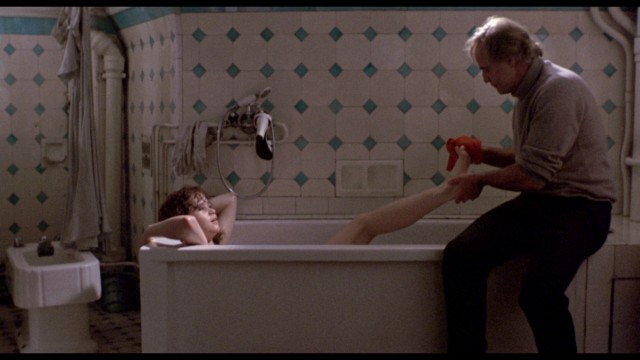
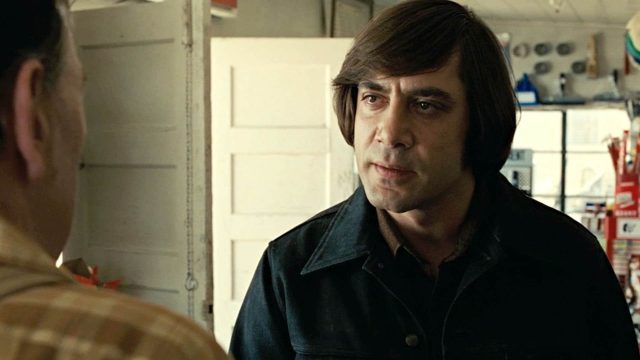
 For more than thirty years, Joel and Ethan Coen have been capturing the American zeitgeist like no one else, penetrating deep into the psyche of the country as well as the history of cinema. MoMA is honoring the pair in their Modern Matinees series, screening fifteen of their films at 1:30 through December 29. Based on the novel by Cormac McCarthy, the Coen brothers’ No Country for Old Men is a gripping thriller dominated by the mesmerizing performance of Javier Bardem as Anton Chigurh, a psychopathic killer who believes in chance. When Llewelyn Moss (an outstanding Josh Brolin) accidentally stumbles upon the site of a drug deal gone terribly wrong, he walks away with a satchel of cash and the dream of making a better life for him and his wife (Kelly MacDonald). He also knows that there will be a lot of people looking for him — and the two million bucks he has absconded with. On his trail are the Mexican dealers who were ripped off, bounty hunter Carson Wells (Woody Harrelson), and the cool, calm Chigurh, who leaves a bloody path of violence in his wake. Meanwhile, Sheriff Bell (Tommy Lee Jones) philosophizes on the sorry state of the modern world as he follows the proceedings with an almost Zen-like precision. Though it struggles to reach its conclusion, No Country for Old Men is an intense noir Western, an epic meditation on chance in which the flip of a coin can be the difference between life and a horrible death. No Country for Old Men is screening at MoMA on November 29; the series features the below films as well as Fargo, Intolerable Cruelty, Blood Simple, Raising Arizona, Miller’s Crossing, Barton Fink, and The Hudsucker Proxy.
For more than thirty years, Joel and Ethan Coen have been capturing the American zeitgeist like no one else, penetrating deep into the psyche of the country as well as the history of cinema. MoMA is honoring the pair in their Modern Matinees series, screening fifteen of their films at 1:30 through December 29. Based on the novel by Cormac McCarthy, the Coen brothers’ No Country for Old Men is a gripping thriller dominated by the mesmerizing performance of Javier Bardem as Anton Chigurh, a psychopathic killer who believes in chance. When Llewelyn Moss (an outstanding Josh Brolin) accidentally stumbles upon the site of a drug deal gone terribly wrong, he walks away with a satchel of cash and the dream of making a better life for him and his wife (Kelly MacDonald). He also knows that there will be a lot of people looking for him — and the two million bucks he has absconded with. On his trail are the Mexican dealers who were ripped off, bounty hunter Carson Wells (Woody Harrelson), and the cool, calm Chigurh, who leaves a bloody path of violence in his wake. Meanwhile, Sheriff Bell (Tommy Lee Jones) philosophizes on the sorry state of the modern world as he follows the proceedings with an almost Zen-like precision. Though it struggles to reach its conclusion, No Country for Old Men is an intense noir Western, an epic meditation on chance in which the flip of a coin can be the difference between life and a horrible death. No Country for Old Men is screening at MoMA on November 29; the series features the below films as well as Fargo, Intolerable Cruelty, Blood Simple, Raising Arizona, Miller’s Crossing, Barton Fink, and The Hudsucker Proxy.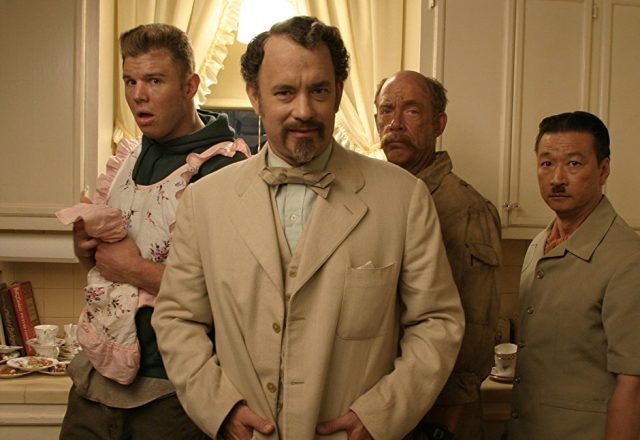
 By far the worst film the Coen brothers have ever made, this remake of the classic 1955 Alexander Mackendrick caper comedy is a travesty from start to finish, an absolute embarrassment to all involved, including Tom Hanks, Irma P. Hall, Marlon Wayans, J. K. Simmons, Tzi Ma, Ryan Hurst, and Diane Delano. Did anyone actually watch this film before they released it? We barely smiled once and never laughed at this ridiculous story of a group of losers using a woman’s root cellar as home base to rob a riverboat casino. Besides not being the slightest bit funny, the movie is also racist, as every black actor in the film is playing a stereotype. We get the Coens, but we don’t get this. Was it meant to be ironic? Cynical? Slapstick? All we know is that it’s just plain awful. The Ladykillers is screening at MoMA November 24.
By far the worst film the Coen brothers have ever made, this remake of the classic 1955 Alexander Mackendrick caper comedy is a travesty from start to finish, an absolute embarrassment to all involved, including Tom Hanks, Irma P. Hall, Marlon Wayans, J. K. Simmons, Tzi Ma, Ryan Hurst, and Diane Delano. Did anyone actually watch this film before they released it? We barely smiled once and never laughed at this ridiculous story of a group of losers using a woman’s root cellar as home base to rob a riverboat casino. Besides not being the slightest bit funny, the movie is also racist, as every black actor in the film is playing a stereotype. We get the Coens, but we don’t get this. Was it meant to be ironic? Cynical? Slapstick? All we know is that it’s just plain awful. The Ladykillers is screening at MoMA November 24.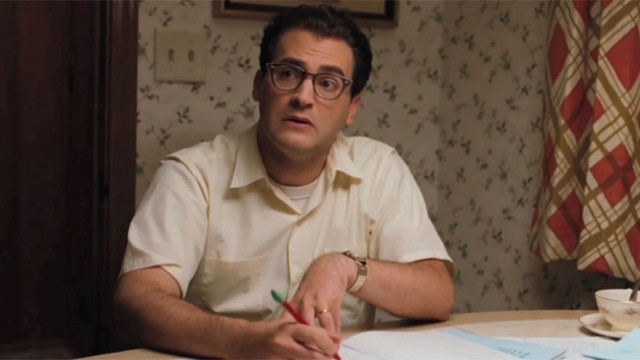
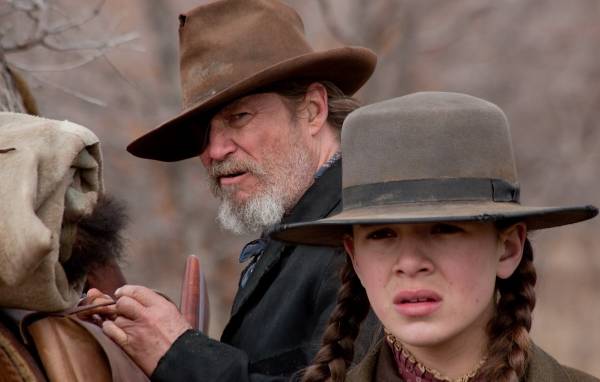

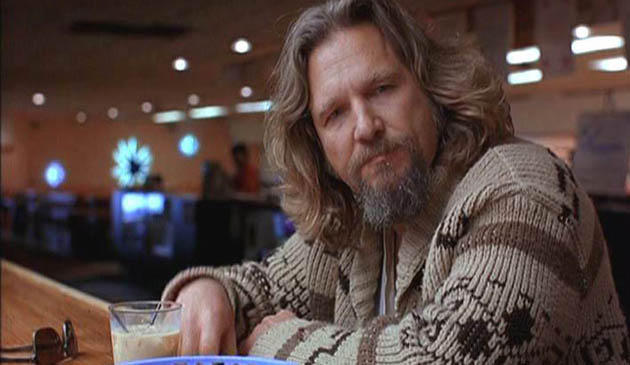
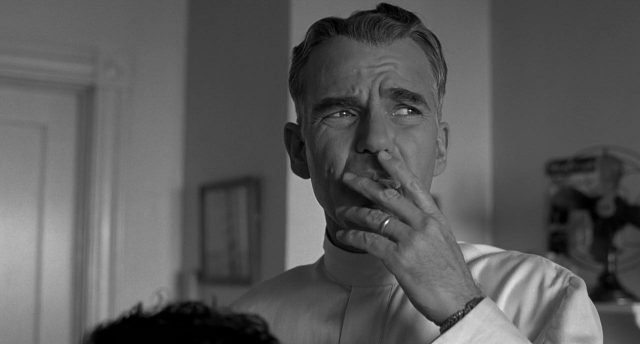
 The first half of this Coen brothers movie is stupendous. Shot in color by Roger Deakins and processed in magnificent black and white to get a richer palette, the film tells the story of Ed Crane, Billy Bob Thornton’s best role yet, a barber with almost nothing to say — ever. When he does talk, he talks slow, slower than he walks. Even his voice-over narration is delivered in a slow monotone. For about forty-five minutes, the pace is fabulous, but then it begins wearing down as the plot goes all over the place. It feels like the Coens had a bunch of different film ideas and decided to throw them all into the last hour of this movie, which seems to go on and on and on and on, with at least four places where you’ll think it’s over. The laughs go away, and a creepy, unfriendly moodiness pervades. At least you can still keep track of the awesome wigs that many of the male characters wear, and for the Californians out there it might be fun guessing the shooting locations, because much of the film was not shot on studio sets. Locations include Musso and Frank’s, a Presbyterian church on Wilshire Blvd., an empty Bank of America branch in Los Angeles, an abandoned furniture store in Glendale, Bungalow Heaven and Castle Green in Pasadena, and the streets of Orange in Orange County. The rather remarkable cast also includes Frances McDormand, Michael Badalucco, Richard Jenkins, Scarlett Johansson, Jon Polito, Tony Shalhoub, and James Gandolfini. The Man Who Wasn’t There is screening December 27 at MoMA.
The first half of this Coen brothers movie is stupendous. Shot in color by Roger Deakins and processed in magnificent black and white to get a richer palette, the film tells the story of Ed Crane, Billy Bob Thornton’s best role yet, a barber with almost nothing to say — ever. When he does talk, he talks slow, slower than he walks. Even his voice-over narration is delivered in a slow monotone. For about forty-five minutes, the pace is fabulous, but then it begins wearing down as the plot goes all over the place. It feels like the Coens had a bunch of different film ideas and decided to throw them all into the last hour of this movie, which seems to go on and on and on and on, with at least four places where you’ll think it’s over. The laughs go away, and a creepy, unfriendly moodiness pervades. At least you can still keep track of the awesome wigs that many of the male characters wear, and for the Californians out there it might be fun guessing the shooting locations, because much of the film was not shot on studio sets. Locations include Musso and Frank’s, a Presbyterian church on Wilshire Blvd., an empty Bank of America branch in Los Angeles, an abandoned furniture store in Glendale, Bungalow Heaven and Castle Green in Pasadena, and the streets of Orange in Orange County. The rather remarkable cast also includes Frances McDormand, Michael Badalucco, Richard Jenkins, Scarlett Johansson, Jon Polito, Tony Shalhoub, and James Gandolfini. The Man Who Wasn’t There is screening December 27 at MoMA.

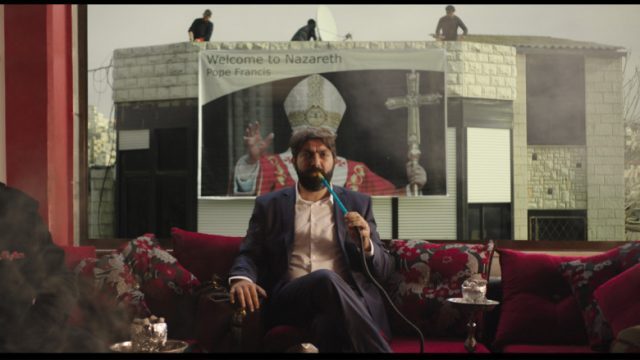
 The opening scene of Shady Srour’s Holy Air, which had its world premiere at the Tribeca Film Festival and then was the closing night selection of the Other Israel Film Festival, is utterly charming, as married couple Adam (Srour), a businessman, and Lamia (Laëtitia Eïdo), the head of the Sexuality Center, are stuck in ridiculously heavy traffic. Lamia decides to use the extra time to take a pregnancy test, urinating right there in the car. That is shortly followed by one of the film’s most splendid images, of Adam in the bathtub, his heavily bearded face above the back edge, a glass of alcohol at the ready as the camera stays still. Unfortunately, the film is shaky the rest of the way, too repetitive and fussy with subplots that don’t feel natural. Whereas Lamia is pregnant, Adam’s father is a tough old guy, fighting cancer. Adam’s partnership with his friend Mahmoud isn’t going well, so, soon after encountering a priest singing the holy praises of Mount Precipice, Adam decides to bottle the air on the mountain and sell it as a tourist souvenir. The film takes on the Christian faith, capitalism, road rage, local gangsters, and growing old, but it works best when it focuses on Adam and Lamia together; just about everything else is overly sentimental, too goofy, or just plain nonsensical, which is too bad, because Srour (Sense of Need) and Lamia (Cleopatra in The Destiny of Rome) make for a lovable couple, caught up in the travails of modern-day Nazareth.
The opening scene of Shady Srour’s Holy Air, which had its world premiere at the Tribeca Film Festival and then was the closing night selection of the Other Israel Film Festival, is utterly charming, as married couple Adam (Srour), a businessman, and Lamia (Laëtitia Eïdo), the head of the Sexuality Center, are stuck in ridiculously heavy traffic. Lamia decides to use the extra time to take a pregnancy test, urinating right there in the car. That is shortly followed by one of the film’s most splendid images, of Adam in the bathtub, his heavily bearded face above the back edge, a glass of alcohol at the ready as the camera stays still. Unfortunately, the film is shaky the rest of the way, too repetitive and fussy with subplots that don’t feel natural. Whereas Lamia is pregnant, Adam’s father is a tough old guy, fighting cancer. Adam’s partnership with his friend Mahmoud isn’t going well, so, soon after encountering a priest singing the holy praises of Mount Precipice, Adam decides to bottle the air on the mountain and sell it as a tourist souvenir. The film takes on the Christian faith, capitalism, road rage, local gangsters, and growing old, but it works best when it focuses on Adam and Lamia together; just about everything else is overly sentimental, too goofy, or just plain nonsensical, which is too bad, because Srour (Sense of Need) and Lamia (Cleopatra in The Destiny of Rome) make for a lovable couple, caught up in the travails of modern-day Nazareth.